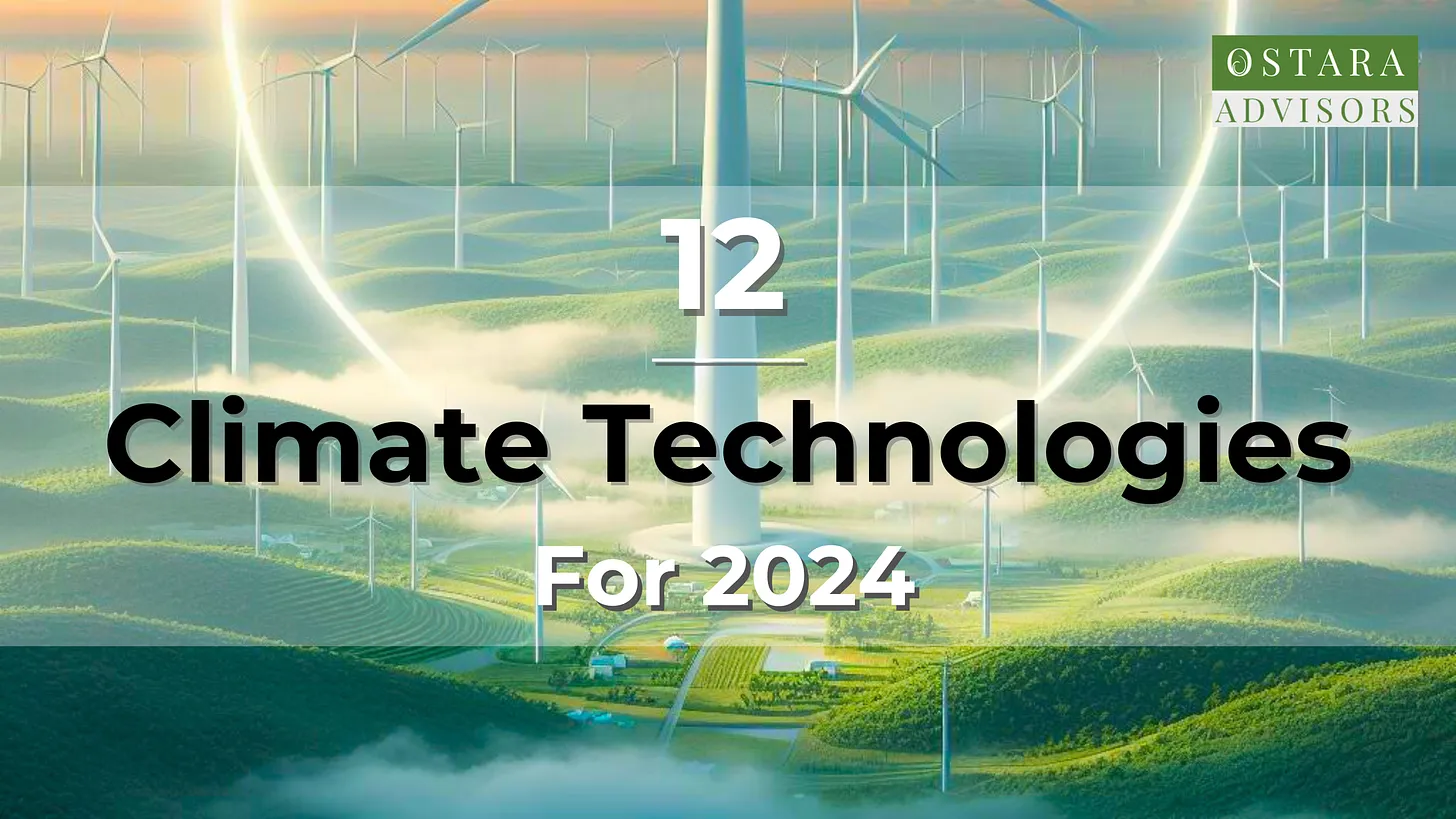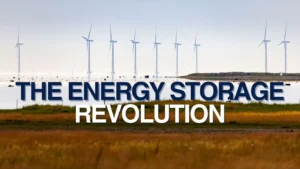Welcome to the year-ending edition of The Ostara Newsletter! We close 2023 with a preview of 12 Climate Technologies that are likely to define 2024, drawn from McKinsey’s Climate Tech Preview published in Dec 2023, corroborated with our own Ostara Insights over the years. These 12 technologies are highly interconnected and hold the potential to reduce as much as 90% of total man-made greenhouse gas (GHG) emissions if deployed at scale. We summarize each one and also highlight India’s actions in that space.
So, let’s dive right in!

Batteries
As the world transitions towards lower tail-pipe emissions in Mobility and greater use of Renewable Energy, the Battery occupies centre-stage. Lithium-ion batteries play a crucial role in addressing intermittency through energy storage. Battery electric vehicles (BEVs) relying on lithium-ion batteries benefit from high “tank to wheel” energy efficiency and exhibit a remarkable 85% reduction in lifetime emissions compared to their internal combustion engine counterparts.
Near-term innovations focus on increasing energy density and fast-charging capabilities. This entails a keen focus on cutting-edge materials like silicon nanostructures and advancements in battery-recycling technologies, advancing to both semi-solid-state and solid-state batteries to store more energy per kilogram of battery weight.
India’s Plans and Progress As of 2023, India has witnessed a surge in EV adoption, with an impressive 40.9% YOY increase, leading to 1.44 million registered BEVs till December 15, 2023 (Source Vahan Dashboard)
Ostara Insights: We wrote about this crucial Climate Technology recently as well. Click here for our deep-dive “Batteries – the Key to Energy Transition?”
Renewables
Renewable power capacity nearly doubled globally from 2015 to 2020, with solar photovoltaics (PV) and onshore/offshore wind turbines seeing significant growth. While technologies like solar and wind are mature, challenges such as intermittency, medium- to long-duration storage integration, and grid modernization persist. Technological innovations, including perovskite solar cells for higher efficiency and organic thin film cells for flexibility at lower costs, are crucial for further cost reduction. Floating offshore platforms and airborne wind energy systems also hold the potential for mass commercial scaling, emphasizing the ongoing need for advancements in renewable energy technologies.

India’s Plans and Progress
As of July 31, 2023, India’s installed renewable energy capacity (including hydro) stood at 177.73 GW, representing 41.9% of the overall installed power capacity. India generated 160.78 billion kWh of electricity from renewable sources in 2022
Ostara Insights: Way back in Sep 2021, we published our insights on India’s Renewable Energy capacity as well as the Energy needs of EVs! Click here to read.
CCUS

Carbon capture, utilization, and storage (CCUS) technologies capture CO2 emissions from industrial processes and then transport it, convert it, or store it long term. Essential for low-carbon hydrogen production, CCUS becomes crucial for residual emissions after other reduction efforts. Ongoing innovations in capture methods, including liquid solvents, solid adsorbents, membranes, and cryogenic techniques, aim to reduce energy use and costs. To scale up, a supportive regulatory environment for pipelines and storage is necessary, given that CCUS represents an additional cost for industrial and power sectors.
India’s Plans and Progress India has been actively moving towards adopting CCUS technologies, including establishing two National Centers of Excellence in CCUS and participating in initiatives like the Mission Innovation Challenge and Accelerating CCS Technologies (ACT) global consortium.
Ostara Insights: Check out our Nov 2023 focus on CCUS here.
Circular Technologies
These cover a range of approaches that aim to reduce the CO2 emissions from materials over their life span while simultaneously maximizing their lifetime value. Scaling material recirculation hinges on collaborative supply chains and investments in waste-management infrastructure for efficient circularity across industries. Recent advancements such as plastic pyrolysis and advanced sorting methods require further innovation for widespread adoption.
India’s Plans and Progress
To expedite the transition of India from a linear to a circular economy, 11 committees have been formed—to be led by the concerned line ministries and comprising officials from Ministry of Environment, Forest and Climate Change (MoEFCC) and National Institution for Transforming India (NITI Aayog), domain experts, academics and industry representatives—for 11 focus areas, responsible for preparing comprehensive action plans for transitioning from a linear to a circular economy in their respective focus areas in the near future.
Ostara Insights: We wrote about Circularity in the Automotive Industry in our October newsletter!
Energy storage
As renewable energy continues to expand, the importance of large-scale energy storage becomes paramount. Technologies like lithium-ion batteries are employed for short- and medium-duration storage, while various electrochemical, thermal, mechanical, and chemical systems cater to long-duration storage needs. By 2030, energy storage could require capacity of 350 GW for short- to mid-duration storage and 400 GW for long-duration storage. While some technologies like pumped hydro and molten salt have reached maturity, ongoing innovation in materials is crucial. For stationary batteries, the focus lies on materials like sulfur and silicon.
India’s Plans and Progress
The Union Budget 2022-23 set the stage for upcoming missions, notably the National Green Hydrogen Mission, while also fostering the development of energy storage solutions through various programs. Earlier, The Government of India on 12th May 2021 approved the Production Linked Incentive (PLI) scheme, ‘National Programme on Advanced Chemistry Cells (ACC) Battery Storage’ in order to promote manufacturing in the country, with a budgetary outlay of ~ $2.3 bn. The scheme envisages establishing cumulative ACC battery manufacturing capacity of 50 GWh. The details of the scheme may be seen here.
Ostara Insights: We wrote about Types of Energy Storage & India’s Energy Storage market just a few months ago in Sep 2023!
Engineered Carbon removals
Carbon removal technologies, including methods such as Direct Air Capture and Storage (DACS), Bioenergy Carbon capture and Storage (BECCS), biochar, bio-oil, and enhanced weathering, are instrumental in the pursuit of achieving net-zero emissions by 2050. These innovative technologies actively extract atmospheric CO2, with DACS specifically filtering and storing CO2 directly, BECCS capturing biogenic emissions from biomass use, and enhanced weathering boosting carbon storage in rocks. For these technologies to gain widespread acceptance, it is imperative to focus on reducing costs significantly.
India’s Plans and Progress
Established in Aug 2022, NTPC’s Pilot CO2 Capture and Conversion Project at Vindhyachal Power Plant marks a significant stride in showcasing the practicality of harnessing captured CO2 as a valuable resource. It successfully captures ~ 20 tons of CO2 daily from a 500 MW unit. Functioning as a stepping stone, this project lays the groundwork for larger-scale CCU projects in India. More details here.
Heat pumps
Heat pumps, surpassing the efficiency of gas furnaces by 2.0 to 4.5 times, operate through refrigerant cycles to facilitate heat transfer. Although Air-source, Geothermal, and Water-source heat pump technologies have reached a level of maturity, unlocking further cost-effectiveness and efficiency demands innovation at the component level. To expand deployment, it is imperative to not only enhance the technology but also innovate in business models, funding mechanisms, and workforce training.
India’s Plans and Progress
India emphasizes heat pump technology in its climate strategy, offering capital subsidies and actively participating in Mission Innovation. Launching initiatives like the solarisation of the sun-temple town of Modhera, Gujarat, incorporating heat pumps for efficient space heating and cooling.
Hydrogen
Clean hydrogen, whether renewable or low carbon, plays a crucial role in the potential deep decarbonization of sectors like steel, cement, and chemicals that account for ~20% of global emissions. Hydrogen, along with its derivatives such as ammonia and methanol, presents viable solutions for addressing emissions in heavy transportation and providing energy storage capabilities.
India’s Plans and Progress
India, with its National Green Hydrogen Mission, aims to increase the Hydrogen production capacity to 5 million metric tonnes per annum by 2030, coupled with a renewable energy addition of 125 GW. With a focus on attracting over 12 Billion USD in investments, creating jobs, and fostering green hydrogen exports, India is set to revolutionize its energy landscape. The mission also emphasizes indigenous manufacturing, research and development, and the establishment of Green Hydrogen Hubs, solidifying India’s commitment to a cleaner and greener future.
Ostara Insights: Read our explainer on Hydrogen written in Dec 2021 here
The Other Core Climate Technologies
Other Core Climate Technologies for decarbonisation include greater use of Clean Nuclear energy, Sustainable fuels including conventional Biomass-based, drop-in hydrogen-based e-fuels, and non-drop-in fuels like e-ammonia and e-methanol, Tech to produce alternative proteins and Nature-based projects including afforestation, reforestation, forest and peatland protection, peatland restoration, and agricultural practices to remove or prevent carbon emissions.
Do write to us with your views and thoughts on this edition at contact@ostara.co.in
As we approach the year-end, here’s a snap from the much-anticipated January Year-round Investment insights, exclusively from Ostara Advisors.

Stay tuned for our January 2024 Newsletter, where we’ll delve even deeper into the trends and deals in the EV investment landscape in India.
















